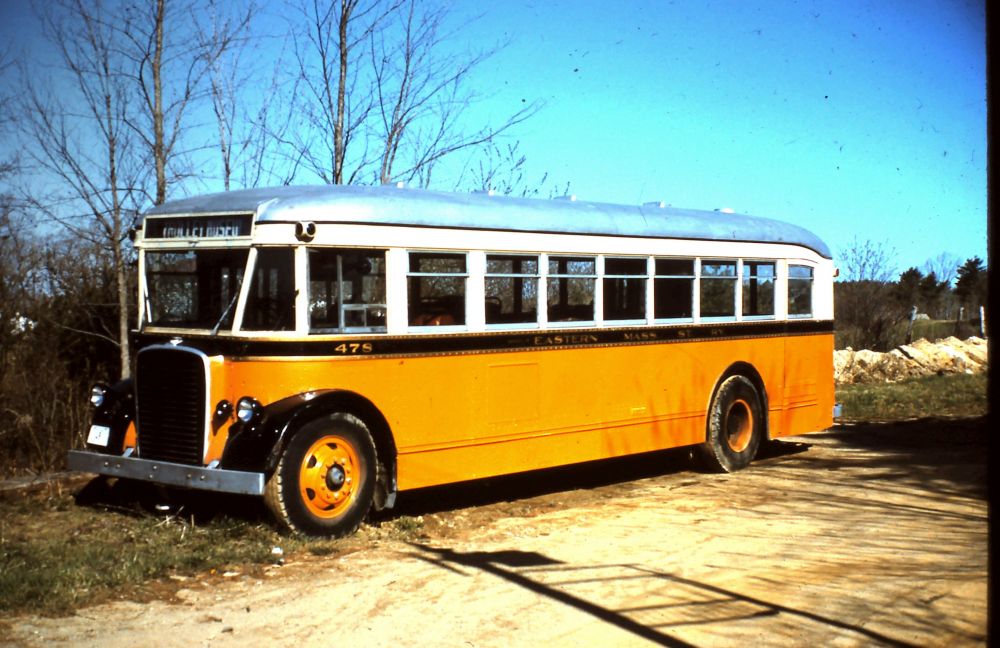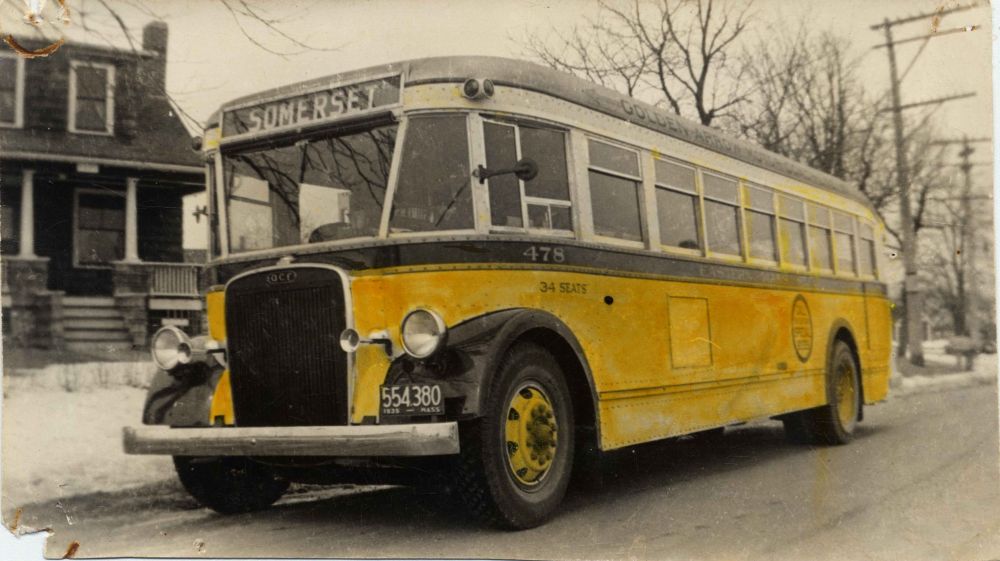
Russel Monroe in April 1962
- Builder
- American Car & Foundry Co.
- Description
- Model H-9-S
- Type
- Motor Buses
- Year
- 1934
- Acquired by the Museum
- 1962
- Note
- In 1965, a problem developed with the carburetor, which has yet to be corrected, and the bus hasn’t run since. There has also been a discussion about a possible cracked block. It has been stored in Central.
Eastern Mass. St. Ry. 478
From Massachusetts
History
The Eastern Massachusetts Street Railway’s (EMSRy) predecessor Bay State Street Railway went into receivership in 1917. At that time approximately 200 miles of streetcar lines had been discontinued. The line was reorganized in 1919, and by 1924 EMSRy was operating a fleet of 36 buses over approximately route 55 miles. By 1935, only one streetcar line remained – Boston to Quincy – which would eventually be converted to bus in May 1st, 1948. By 1946, it was operating 808 buses over 861 miles and 37 streetcars on 18.71 miles of track. In 1968, it was acquired by the MBTA.
ACF – Brill Timeline
1924, May – J.G. Brill purchases part interest in Fageol Motor of Ohio – a coachbuilder,
hoping that by acquiring the bus manufacturer it could grow its share of the new market.
1925, September – ACF, J.G. Brill and unknown party (Fageol) acquire Hall-Scott Motor Car Company – Hall-Scott produced light, fast and powerful gasoline engines that
powered the Fageol coaches.
1925, December – Fageol of Ohio was consolidated into new cooperation in which ACF
& Brill have a major interest. Company now known as American Car & Foundry
Motors to own ACF’s holding in Hall-Scott (100%) and Fageol of Ohio (90%)
1926, January – New Holding Company – Brill Corporation – J.G. Brill owned a
substantial but minority interest and ACF owned 64%. Brill Corporation owned
ACF Motors, which in turn owned Hall-Scott, and controlled Fageol of Ohio and
almost all of J.G. Brill.
In 1926 American Car & Foundry Motor Company (Brill Corporation) was competing for the transit and parlor bus market with White, Mack and Yellow Bus (which was absorbed G.M.C.). Their strongest seller model at the time was the Fageol Safety Coach Over-The-Road 29 passenger bus, with a wheelbase of 203”, a 6 cylinder Hall-Scott 90 HP gasoline engine. It had a mechanical transmission and mechanical brakes.
ACF began to concentrate on the large urban system market. Brill was well position for this with their connections with the streetcar companies, and applying their knowledge of streetcar operations and design as it applied to designing the replacement buses. ACF used their knowledge of railcar design to redesign the construction of the buses. Up to 1932, ACF’s most popular urban bus was the flat nosed Metropolitan, which featured a vertical engine which extended into the passenger compartment. Its 110 hp engine did not perform well, the seats over the engine were not, the engine lids became loose, admitting fumes, the engine was noisy and, wherever work had to done on the motor, it had to be done inside the passenger compartment, meaning grease and dirt. In 1932, ACF tested a flat nosed bus along the line of the Metropolitan, but with an under-the-floor horizontal motor. This new positioning of the motor improved weight distribution, drive train layout and transmission design, as well as reducing engine noise and exhaust fumes in the passenger compartment. In June of 1933, they came out with their 180-A-H9. They soon dropped the “chassis model” nomenclature, and model simply became the H-9-S for urban buses and H-9-P for over-the-road.
The H-9s were all metal buses, with a chassisless design, with the sides serving as the load carrying members. The under framing and body framing were built as a unit using small, separate members riveted together and secured with gussets. Center sills, engine supports and those cross members that held the engine supports and spring brackets were of steel and the rest of the framing aluminum alloy. The body paneling was aluminum throughout. The roof was formed with closely spaced hardwood slats laid on wood-filled steel carlines, covered with canvas over felt padding. The H-9-S continued in production until 1941.
In 1933, EMSRy placed its first order for ACF-Brill’s Model H-9-S . The manufacturer produced two versions of the H-9 series – H-9-S & H-9-P. ‘S’ denoted streetcar type for city and interurban service and ‘P’ for parlor or highway bus. The ‘P’ series seated 36. Eventually Eastern Massachusetts placed an order for 44 buses of the H-9-S series:
Early 1933 435
Late 1933 436 thru 440
1934 441 thru 483
January, 1935 484 thru 490
The company also ordered 19 short versions of the model which seated 29 and were numbered 701 thru 719. Model H-9-S buses were also purchased by the Boston Elevated Railway, Boston & Worcester Street Railway and New England Transportation Co. Boston Elevated ran at least four – Numbers 1620 thru 1624.
Numbers 478 thru 783 were delivered in a livery of white with a black belt rail scheme and silver roof and seated 34 people. The rest of the order had city seating of 39 and were painted orange and cream with the black belt rail scheme with silver roof. In 1939, Numbers 478 and 479 were overhauled and painted a special blue and white for service on the Fall River Express which operated from the Park Square Greyhound Terminal. As a note, EMSRy maintained its service on its Fall River Division until 1965, when it was sold to Short Line, which became Bonanza Bus Lines, which became a subsidiary of Peter Pan Bus Lines. Then is late 1945, No. 478 and No. 479 were converted to city seating and painted orange and cream, returning to service on the Melrose Division. Finally, in the mid 50’s, it was retired from revenue service and became tow bus S-478, and was assigned to the Brockton Division.
Number 478 was the first bus acquired by the Seashore Trolley Museum. No. 478 was donated by Eastern Massachusetts Street Railway and arrived at the Museum under its own power. The first project was bolting down the seats, since they had been removed for tow service. Interestingly, the seats were manufactured by Haywood-Wakefield in Gardner, MA.
Number 478 made 3 trips to Boston after coming to the Museum. In 1972, it travelled to Boston to help celebrate the 50th Anniversary of Bus Transportation in Boston held February 24th and 25th. It sat at Boston City Hall Plaza next to a brand new Flxible Model CD-111. On May 17th, 1989, it was again at City Hall Plaza for MBTA National Transit Appreciation Day, the trip arranged by Bradley Clarke and George Sanborn. , and returned on October 28, 1989 to be displayed at the Everett Shops for Everett Shops Family Day.
Technical Information
- Seats: 40
- Engine: Hall-Scott
- Tires: 11.00 x 20
Weight and Dimensions
- Length: 31’ 4.00"
- Width: 93.00"
- Weight: 17000 lbs.
Additional Images

Leo Sullivan Collection Colorized by EMSR 1935
© 1998 - 2026 New England Electric Railway Historical Society. All Rights Reserved.